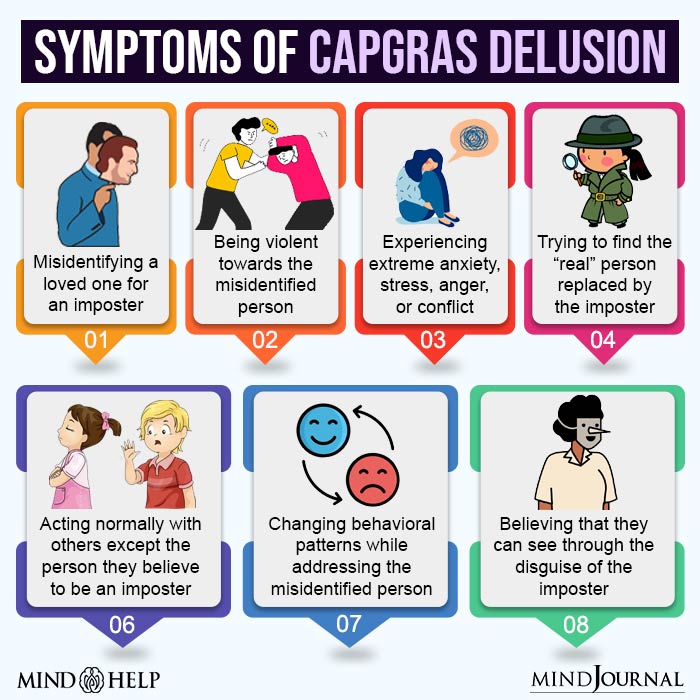Capgras delusion occurs when a person believes that a family member has been replaced by a stranger.
The delusion was named after psychiatrist Joseph Capgras who published a paper in 1953 detailing the case of 53 year old woman who believed her husband had been replaced by a stranger. (Coltheart & Davies, 2022).
Overview of Capgras Delusion
While initial cases and definitions of Capgras delusion were restricted to people who believe family members has been replaced, and this holds for the majority of occurrences, there are many cases where a person believes that acquaintances, such as neighbors, coworkers, or physicians, were replaced.
Capgras delusion even encompass the belief that a pet was replaced, such as dogs, cats, or birds.
Furthermore, there are cases where a person believes personal objects are replicas or facsimiles, such as furniture, letters written to them, plants on their property or even their entire home.
The crux of the definition for Capgras delusion is that something familiar has been replaced with something unfamiliar. (Coltheart & Davies, 2022).
In Depth Exploration of Capgras Delusion
The experience of Capgras delusion mainly involve the visual and auditory system, although usually not at the same time. The sensation is that of seeing or hearing a person who has the shape or voice of someone familiar, even intimate, yet are devoid of the recognition that the person they are interacting with are actually the person they know. It is not that a person with Capgras cannot identify or will misidentify the people they know, but they believe the person they are familiar with has been replaced by someone else.
Someone with Capgras delusion may no longer recognize a familiar person through sight, yet can recognize that same person only when hearing them, such as in a phone call.
Alternatively, someone may no longer recognize a person through their voice, and be convinced they are talking to an imposter, yet will recognize that person when they see them.
Non-sighted persons who gain familiarity with others through voice can develop Capgras delusion; the voice becomes an imitation of a person by a stranger. (Coltheart & Davies, 2022).

Patient with Capgras Delusion Explained by V.S. Ramachandran
Capgras delusion is not a disorder that manifests on its own, but is a symptom of a psychiatric disorder that can be a functional or organic diagnosis. Examples of functional diagnoses include schizophrenia, bipolar affective disorder, and OCD. Organic diagnoses include delirium, dementia, and drug related disorders.
Capgras delusions can be co-morbid with other symptoms such as paranoid delusions, dissociation, aggression, hallucinations, and formal thought disorder. (Panis et al., 2019).
The prevailing explanation for what cause Capgras delusion is the Anderson disconnection hypothesis, who posited that the delusion is caused by a lesion in the visual recognition pathway that disrupts the representation of a person or object from associating with an emotional response due to familiarity. Seeing a familiar person or object without the expected emotional reaction results in an incongruity that is rationalized that the representation is not what it physically resembles.
Support for this explanation is supported through experimentation where patients with Capgras delusion were measured for activity in the sympathetic nervous system using the method of skin conductance response, which are indicative of an emotional reaction. Normally, a higher skin conductance is associated with seeing familiar faces. Patients with Capgras delusion failed to show a skin conductance response when shown familiar faces, supporting the disconnection hypothesis.
According to the two-factor theory of delusional belief, there is the initial impetus that caused the delusional idea, and a second factor that explains why the delusional belief is accepted and maintained instead of getting rejected. The first factor for Capgras delusion is explained by the dissociation hypothesis, where patients will fail to have a sympathetic nervous system response to a familiar person or object. The second factor is explained by damage to the right dorsolateral prefrontal cortex, which is seen in patients with Capgras delusion, and is involved in belief evaluation. Essentially, people with delusions are indefinitely caught in suspension of disbelief. (Coltheart & Davies, 2022).
Traumatic injury to the head that causes a neurological disorder may also lead to symptoms of Capgras delusion. (Duff, 2017).
Psychologist Details Experience and Treatment of Patients with Capgras Delusion
Interventions for Capgras delusion involve treating the underlying psychiatric disorder that caused the delusion, using medication such as anti-psychotics, anti-depressants, anti-dementia, or anti-epileptic mood stabilizers as appropriate. (Pandis et al., 2019).
Psychological interventions involve playing along with the delusion and matching the reality of the patient, since it is extremely difficult to redirect the belief system of people suffering with delusions. If the delusion is causing anxiety, it can be helpful to uncover what the main fear is, and reassure the patient that they have no reason to worry, using some kind of evidence that is not tied to the people they see as replaced. While it is not always effective, or is only a temporary fix, delusions can be defeated by using interacting with a patient using the none-compromised recognition system, such as hearing, and slowly bringing the “replaced” person into the field of the compromised recognition system, such as vision. (Duff, 2017).
Coltheart, M., & Davies, M. (2022). What is Capgras delusion?. Cognitive Neuropsychiatry, 27(1), 69-82. https://doi.org/10.1080/13546805.2021.2011185
Cogmonaut (2010, January 19). Capgras’ delusion patient [Video]. YouTube. https://www.youtube.com/watch?v=dqBGzkz1oDU&feature=youtu.be
Mind Journal. (2022, July 16). What Is Capgras Delusion? Delusional Misidentification Syndrome. Mind Help. https://mind.help/topic/capgras-delusion/
Pandis, C., Agrawal, N., & Poole, N. (2019). Capgras’ delusion: A systematic review of 255 published cases. Psychopathology, 52(3), 161-173. https://doi.org/10.1159/000500474
Duff The Psych. (2017, October 23). Don’t Tell My Wife. . . | Capgras Syndrome [Video]. YouTube. https://www.youtube.com/watch?v=eBaL36d_iLk&feature=youtu.be
Tiny Medicine. (2020, September 25). Capgras Delusion (Impostor Syndrome): Bizarre Neurological Disorder [Video]. YouTube. https://www.youtube.com/watch?v=L3ubWzTB08s&feature=youtu.be
Professor Graeme Yorston. (2022b, September 9). The Dangerous Delusion of Doubles – Capgras Syndrome – Mental Disorder Documentary [Video]. YouTube. https://www.youtube.com/watch?v=a7sX7yr_Ni4&feature=youtu.be